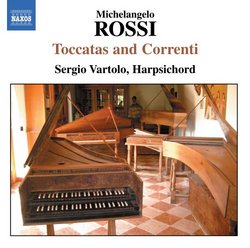| All Artists: Michelangelo Rossi, Sergio Vartolo Title: Michelangelo Rossi: Toccatas and Correnti Members Wishing: 0 Total Copies: 0 Label: Naxos Original Release Date: 1/1/2005 Re-Release Date: 6/21/2005 Genre: Classical Styles: Chamber Music, Historical Periods, Baroque (c.1600-1750), Classical (c.1770-1830) Number of Discs: 1 SwapaCD Credits: 1 UPC: 747313232123 |
Search - Michelangelo Rossi, Sergio Vartolo :: Michelangelo Rossi: Toccatas and Correnti
 | Michelangelo Rossi, Sergio Vartolo Michelangelo Rossi: Toccatas and Correnti Genre: Classical
|
Larger Image |
CD Details |
CD ReviewsSergio Vartolo Explores Another Byway of the Italian Baroque J Scott Morrison | Middlebury VT, USA | 08/06/2005 (4 out of 5 stars) "We have much to thank Italian musicologist/harpsichordist Sergio Vartolo for. He has recorded much from the early Italian baroque, including the valuable series containing music of Giovanni Maria Trabaci (c. 1575-1647). His booklet notes tend to be a fount of detailed musicological information, and that is certainly true in the present case. Not much is known about Michelangelo Rossi (1602-1656); this issue contains all of his extant harpsichord music. It is known that he was not a keyboardist, but rather a violin virtuoso and madrigalist who had studied composition with his uncle, the organist at the church of San Lorenzo in Genoa, and that he undoubtedly had exposure to the important Genoan composer, Sigismondo d'India. Vartolo comments that the keyboard writing is a bit awkward, but the music he produced is unfailingly interesting, if not to say quirky in that quintessentially Italian way we know from others like Gesualdo. Listen, for instance, to the extreme chromaticism in the final moments of the Toccata VII; it does indeed remind one of d'India and Gesualdo, and since the harpsichord Vartolo is using is tuned in meantone (with A=415), the 'out-of-tuneness' in some of those passages contributes to a slightly queasy reaction that is nonetheless fascinating and even bracing. Vartolo is himself a virtuoso and he plays with style and grace throughout.
The CD is divided into two sections. The first contains ten toccatas, each lasting 6-9 minutes, and they are followed by ten correntes, much briefer, at 1-3 minutes each. The toccatas are, understandably, more complex and musically interesting, but the correntes are beguiling with their dance rhythms. I found that when I listened to this disc I would program my player so that each toccata was followed by a corrente in order to avoid stylistic sameness. One could say that Rossi does not have the ability always to write immediately graspable melodies, but over time I found that his idiosyncratic melodic construction (like that of, say, Berlioz on first hearing) has a charm and catchiness all its own. The recorded sound is a bit forward but with plenty of ambient space around the sound. Two different harpsichords are used for the sets of toccatas and correntes; both have a rich and forthright tone. As said, they are tuned in meantone, which means that the black keys are tuned either as flats or sharps as each piece requires. TT=79:31 Scott Morrison" |

 Track Listings (20) - Disc #1
Track Listings (20) - Disc #1